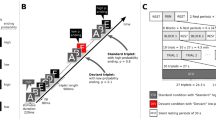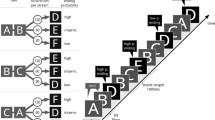Abstract
Humans are highly sensitive to statistical regularities in their environment. This phenomenon, usually referred as statistical learning, is most often assessed using post-learning behavioural measures that are limited by a lack of sensibility and do not monitor the temporal dynamics of learning. In the present study, we used magnetoencephalographic frequency-tagged responses to investigate the neural sources and temporal development of the ongoing brain activity that supports the detection of regularities embedded in auditory streams. Participants passively listened to statistical streams in which tones were grouped as triplets, and to random streams in which tones were randomly presented. Results show that during exposure to statistical (vs. random) streams, tritone frequency-related responses reflecting the learning of regularities embedded in the stream increased in the left supplementary motor area and left posterior superior temporal sulcus (pSTS), whereas tone frequency-related responses decreased in the right angular gyrus and right pSTS. Tritone frequency-related responses rapidly developed to reach significance after 3 min of exposure. These results suggest that the incidental extraction of novel regularities is subtended by a gradual shift from rhythmic activity reflecting individual tone succession toward rhythmic activity synchronised with triplet presentation, and that these rhythmic processes are subtended by distinct neural sources.




Similar content being viewed by others
References
Abla D, Okanoya K (2008) Statistical segmentation of tone sequences activates the left inferior frontal cortex: a near-infrared spectroscopy study. Neuropsychologia 46:2787–2795
Abla D, Katahira K, Okanoya K (2008) On-line assessment of statistical learning by event-related potentials. J Cogn Neurosci 20:952–964
Barnes GR, Litvak V, Brookes MJ, Friston KJ (2011) Controlling false positive rates in mass-multivariate tests for electromagnetic responses. NeuroImage 56:1072–1081
Bertels J, Franco A, Destrebecqz A (2012) How implicit is visual statistical learning? J Exp Psychol Learn Mem Cogn 38:1425–1431
Boyer M, Destrebecqz A, Cleeremans A (2005) Processing abstract sequence structure: learning without knowing, or knowing without learning? Psychol Res 69:383–398
Brainard DH (1997) The Psychophysics Toolbox. Spat Vis 10:433–436
Bruchon-Schweitzer M, Paulhan I (1990) Manuel pour l’inventaire d’anxiété Trait-État (forme Y). ECPA, Paris
Buiatti M, Peña M, Dehaene-Lambertz G (2009) Investigating the neural correlates of continuous speech computation with frequency-tagged neuroelectric responses. NeuroImage 44:509–519
Buysse DJ, Reynolds CF, Monk TH, Berman SR, Kupfer DJ (1989) The Pittsburgh Sleep Quality Index: a new instrument for psychiatric practice and research. Psychiatry Res 28:193–213
Conway CM, Christiansen MH (2005) Modality-constrained statistical learning of tactile, visual, and auditory sequences. J Exp Psychol Learn Mem Cogn 31:24–39
Conway CM, Christiansen MH (2009) Seeing and hearing in space and time: effects of modality and presentation rate on implicit statistical learning. Eur J Cogn Psychol 21:561–580
Cunillera T, Toro JM, Sebastián-Gallés N, Rodríguez-Fornells A (2006) The effects of stress and statistical cues on continuous speech segmentation: an event-related brain potential study. Brain Res 1123:168–178
Cunillera T, Càmara E, Toro JM, Marco-Pallares J, Sebastián-Galles N, Ortiz H, Pujol J, Rodríguez-Fornells A (2009) Time course and functional neuroanatomy of speech segmentation in adults. NeuroImage 48:541–553
Dale AM, Sereno MI (1993) Improved localizadon of cortical activity by combining EEG and MEG with MRI cortical surface reconstruction: a linear approach. J Cogn Neurosci 5:162–176
David M, Gómez RAHB (2011) The word segmentation process as revealed by click detection. Lang. Cogn. Process. 26:212–223
De Diego Balaguer R, Toro JM, Rodriguez-Fornells A, Bachoud-Lévi A-C (2007) Different neurophysiological mechanisms underlying word and rule extraction from speech. PLoS One 2:e1175
De Tiège X, Op de Beeck M, Funke M, Legros B, Parkkonen L, Goldman S, Van Bogaert P (2008) Recording epileptic activity with MEG in a light-weight magnetic shield. Epilepsy Res 82:227–231
Ding N, Melloni L, Zhang H, Tian X, Poeppel D (2016) Cortical tracking of hierarchical linguistic structures in connected speech. Nat Neurosci 19:158–164
Ellis BW, Johns MW, Lancaster R, Raptopoulos P, Angelopoulos N, Priest RG (1981) The St. Mary’s Hospital sleep questionnaire: a study of reliability. Sleep 4:93–97
Franco A, Cleeremans A, Destrebecqz A (2011) Statistical learning of two artificial languages presented successively: how conscious? Front Psychol 2:1–12
Franco A, Gaillard V, Cleeremans A, Destrebecqz A (2014) Assessing segmentation processes by click detection: online measure of statistical learning, or simple interference? Behav Res Methods
François C, Schön D (2014) Neural sensitivity to statistical regularities as a fundamental biological process that underlies auditory learning: the role of musical practice. Hear Res 308:122–128
François C, Tillmann B, Schön D (2012) Cognitive and methodological considerations on the effects of musical expertise on speech segmentation. Ann NY Acad Sci 1252:108–115
François C, Jaillet F, Takerkart S, Schön D (2014) Faster sound stream segmentation in musicians than in nonmusicians. PLoS One 9:e101340
Furl N, Kumar S, Alter K, Durrant S, Shawe-Taylor J, Griffiths TD (2011) Neural prediction of higher-order auditory sequence statistics. NeuroImage 54:2267–2277
Gebhart AL, Aslin RN, Newport EL (2009) Changing structures in midstream: learning along the statistical garden path. Cogn Sci 33:1087–1116
Glicksohn A, Magen H, Cohen A (2015) Statistical learned helplessness in humans. Poster presented at the Interdisciplinary Advances in Statistical Learning, San Sebastian, Spain
Grill-Spector K, Henson R, Martin A (2006) Repetition and the brain: neural models of stimulus-specific effects. Trends Cogn Sci 10(1):14–23
Hickok G, Poeppel D (2007) The cortical organization of speech processing. Nat Rev Neurosci 8:393–402
Horne JA, Ostberg O (1976) A self-assessment questionnaire to determine morningness-eveningness in human circadian rhythms. Int J Chronobiol 4:97–110
Kabdebon C, Pena M, Buiatti M, Dehaene-Lambertz G (2015) Electrophysiological evidence of statistical learning of long-distance dependencies in 8-month-old preterm and full-term infants. Brain Lang 148:25–36
Karuza EA, Newport EL, Aslin RN, Starling SJ, Tivarus ME, Bavelier D (2013) The neural correlates of statistical learning in a word segmentation task: an fMRI study. Brain Lang 127:46–54
Kim R, Seitz A, Feenstra H, Shams L (2009) Testing assumptions of statistical learning: is it long-term and implicit? Neurosci Lett 461:145–149
Kirkham NZ, Slemmer JA, Johnson SP (2002) Visual statistical learning in infancy: evidence for a domain general learning mechanism. Cognition 83:B35–B42
McNealy K, Mazziotta JC, Dapretto M (2006) Cracking the language code: neural mechanisms underlying speech parsing. J Neurosci 26:7629–7639
McNealy K, Mazziotta JC, Dapretto M (2010) The neural basis of speech parsing in children and adults. Dev Sci 13:385–406
McNealy K, Mazziotta JC, Dapretto M (2011) Age and experience shape developmental changes in the neural basis of language-related learning. Dev Sci 14:1261–1282
Möttönen R, Calvert GA, Jääskeläinen IP, Matthews PM, Thesen T, Tuomainen J, Sams M (2006) Perceiving identical sounds as speech or non-speech modulates activity in the left posterior superior temporal sulcus. NeuroImage 30:563–569
Mustovic H, Scheffler K, Di Salle F, Esposito F, Neuhoff JG, Hennig J, Seifritz E (2003) Temporal integration of sequential auditory events: silent period in sound pattern activates human planum temporale. NeuroImage 20:429–434
Oldfield RC (1971) The assessment and analysis of handedness: the Edinburgh inventory. Neuropsychologia 9:97–113
Oostenveld R, Fries P, Maris E, Schoffelen J-M (2010) FieldTrip: open source software for advanced analysis of MEG, EEG, and invasive electrophysiological data. Comput Intell, Neurosci 2011
Peña M, Bonatti LL, Nespor M, Mehler J (2002) Signal-driven computations in speech processing. Science 298:604–607
Perruchet P, Pacton S (2006) Implicit learning and statistical learning: one phenomenon, two approaches. Trends Cogn Sci 10:233–238
R Core Team (2008) A language and environment for statistical computing. R Foundation for Statistical Computing, Vienna
Regan D (1982) Comparison of transient and Steady-State Methods. Ann New-York Acad Sci 388:45–71
Rossion B, Boremanse A (2011) Robust sensitivity to facial identity in the right human occipito-temporal cortex as revealed by steady-state visual-evoked potentials. J Vis 11(2):16
Rossion B, Prieto EA, Boremanse A, Kuefner D, Van Belle G (2012) A steady-state visual evoked potential approach to individual face perception: effect of inversion, contrast-reversal and temporal dynamics. NeuroImage 63:1585–1600
Saffran JR, Aslin RN, Newport EL (1996) Statistical learning by 8-month-old infants. Science 274:1926–1928
Saffran JR, Newport EL, Aslin RN, Tunick RA, Barrueco S (1997) Incidental Language Learning: listening (and Learning) Out of the Corner of Your Ear. Psychol Sci 8:101–105
Saffran JR, Johnson EK, Aslin RN, Newport EL (1999) Statistical learning of tone sequences by human infants and adults. Cognition 70:27–52
Sanders LD, Newport EL, Neville HJ (2002) Segmenting nonsense: an event-related potential index of perceived onsets in continuous speech. Nat Neurosci 5:700–703
Sanders LD, Ameral V, Sayles K (2009) Event-related potentials index segmentation of nonsense sounds. Neuropsychologia 47:1183–1186
Sussman E, Steinschneider M, Gumenyuk V, Grushko J, Lawson K (2008) The maturation of human evoked brain potentials to sounds presented at different stimulus rates. Hear Res 236:61–79
Taulu S, Kajola M, Simola J (2004) Suppression of interference and artifacts by the signal space separation method. Brain Topogr 16:269–275
Teinonen T, Huotilainen M (2012) Implicit segmentation of a stream of syllables based on transitional probabilities: an MEG study. J Psycholinguist Res 41:71–82
Turk-Browne NB, Jungé J, Scholl BJ (2005) The automaticity of visual statistical learning. J Exp Psychol Gen 134:552–564
Turk-Browne NB, Scholl BJ, Chun MM, Johnson MK (2009) Neural evidence of statistical learning: efficient detection of visual regularities without awareness. J Cogn Neurosci 21:1934–1945
Vadillo MA, Konstantinidis E, Shanks DR (2015) Underpowered samples, false negatives, and unconscious learning. Psychon Bull Rev 1:16
Weiss DJ, Gerfen C, Mitchel AD (2009) Speech segmentation in a simulated bilingual environment: a challenge for statistical learning? Lang Learn Dev 5:30–49
Wens V, Marty B, Mary A, Bourguignon M, Op de Beeck M, Goldman S, Van Bogaert P, Peigneux P, De Tiège X (2015) A geometric correction scheme for spatial leakage effects in MEG/EEG seed-based functional connectivity mapping. Hum Brain Mapp 36:4604–4621
Acknowledgments
The authors would like to thank Dr. Rachel Leproult for helping in the data of the first pre-test MEG runs, Dr. Arnaud Destrebecqz for fruitful discussions about this study and Jeromy Hrabovecky for English language corrections. Juliane Farthouat and Alison Mary are Research Fellows, Ana Franco is Post-Doctoral Researcher, Xavier De Tiège is a Post-doctoral Clinical Master Specialist, and Vincent Wens is a Post-doctoral Research Logistician, supported by the Fonds de la Recherche Scientifique (FRS-FNRS, Brussels, Belgium). Julie Delpouve was supported by the ULB Action de Recherches Concertées (ARC) project “Pathophysiology of Memory Consolidation.” P. Peigneux is Francqui Research Professor 2013–2016. This study was supported by FRS-FNRS research project T.109.13 “Learning and Memory in Sleep.”.
Author information
Authors and Affiliations
Corresponding authors
Electronic Supplementary Material
Below is the link to the electronic supplementary material.
Rights and permissions
About this article
Cite this article
Farthouat, J., Franco, A., Mary, A. et al. Auditory Magnetoencephalographic Frequency-Tagged Responses Mirror the Ongoing Segmentation Processes Underlying Statistical Learning. Brain Topogr 30, 220–232 (2017). https://doi.org/10.1007/s10548-016-0518-y
Received:
Accepted:
Published:
Issue Date:
DOI: https://doi.org/10.1007/s10548-016-0518-y




